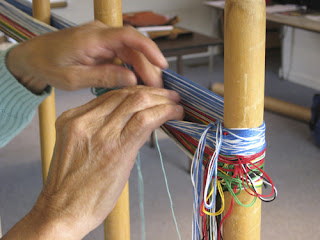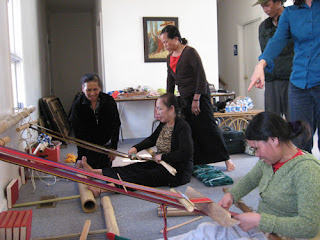[Projects] > Creating A Backstrap Weavers’ Group
Photos from recent meetings, demonstrations and weaving sessions of the Backstrap Weavers in Greensboro, North Carolina
Women interested in backstrap weaving meet to decide on goals.
Weavers listen as Betsy's words are translated into the Rhade and Bunong languages.
Several Nepali recent arrivals attend the meeting as well. Backstrap weaving is a tradition shared by many cultures throughout Southeast and South Asia.
Montagnard leader Y Hin Nie brings cultural guidance and inspiration to the group's meetings.
Linda Evans and H Ngach Rahlan at a recent meeting at the Greensboro Historical Museum.
Sunit Thapa and Devi Timsina visit the Historical Museum's new exhibit, Voices of the City.
Weaver H Ju Nie stands in front of the Historical Museum's display of a baby carrier she wove in Vietnam when she was 15.
H Ju Nie and H Ni Buonya demonstrate Montagnard weaving using traditional Rhade techniques and designs at Greensboro's Hemphill Library during the Cultural Arts Festival in September.
This participant is being shown how to open a new shed to put in the next row of thread.
Then she learns to beat the threads together with a tool called a sword.
Kids seem especially interested in learning backstrap weaving.
Another girl waits her turn.
Weavers meet at a local church to share weaving techniques and working on the project's goals. Betsy is teaching the English weaving terms to Ju Nie while a translator listens.
Visiting weaver Laverne Waddington joins this session to learn more about Montagnard weaving.
Laughter does not need to be translated!
Our translator and Ju explain how weavers keep the edges of their warp edges equidistant.
They demonstrate the use of a temple to keep the edges from pulling inward.
One of our initial challenges was to make a sturdy support to hang the looms from. Here, our heavy duty table barely does the job so we made numerous adjustments. Next week we will anchor supports into the wall but for now this will do!
This weaver carefully inserts her bobbin thread on a double warped loom.
We discuss what we will share at our next meeting.
At our next meeting a bamboo railing is prepared to allow the weavers to anchor their looms onto a sturdy structure.
Voila! Now the weavers can attach their looms to a horizontal bamboo beam. The bamboo foot rests are actually a device that allow the weavers to adjust the tension on their looms.
Visiting weavers Jerry O'Donnell and Laverne Waddington analyze the technical merits of some Montagnard textiles brought in for us to share and admire. Laverne is an Australian weaver, now living in Bolivia, who specializes in backstrap weaving. Her knowledge of textile structures has been a valuable asset to our group.
Jarai weaver Ngach Rahlan and Rhade weaver Ju Nie discuss the design on a recently finished skirt.
Ju sets up a small kteh frame to work on this off-loom technique that involves twining weft threads around warp threads.
This unusual design is probably from Pleiku, one of the towns in the Central Highlands of Vietnam. Was the weaver Bahnar or Rhade? We need many Montagnard weavers to participate in sharing their weaving knowledge but also their knowledge of what designs or techniques were common to each of the major regions in the areas where Montagnards lived.
At our last meeting of 2010, one weaver gave a demonstration of the warping process as part of the project's goal to promote the sharing of weaving experiences. Each woman that participates in this project has agreed to give a demonstration about a weaving process, first in her native language and then later, to a larger audience but in English. After she completes her first presentation she receives materials and supplies to build a loom or warp a new loom to teach a new student.
Mary Ellen Droppers watches the beginning stages of the warping. Mary Ellen has graciously allowed our group to set up in the sanctuary of her church.
Many conversations are going on in the background as the women compare the weaving terms in their native languages of Bahnar, Jarai, and Koho. Khin translates Ju's Rhade into Jarai and then into English.
Ju and Khin examine the pattern they will use to set up the warp. Ju will start with the color on the outside edge, here black.
The women help each other count the number of threads, crucial to creating a symmetrical design with a traditional structure.
Ju checks the thread count, tension, and heddle placement before putting on the next color. She is making a continuous warp with two crossings. If you looked down at the warp from high above you would see something like a figure 8. If a thread goes around one of her poles the wrong way the warp would have to be re-threaded.
Another participant tries her hand at warping.
Ju and Khin check the thread alignment. The warping is almost finished. This warp will only be several inches wide but this board will allow a warp width of about 24 inches.
Now the warp comes off the warping board to be put onto the loom rods.
Ju is one of the few Montagnard women that still knows how to warp.
Ju's husband helps roll up the warp while she inserts the breast beam.
Men traditionally make the loom parts for their wives. Here a newly made set includes a sword, warp beam, shed rod and other parts made of bamboo or wood.
Ju carefully keeps the heddle threads separated to allow a small rod to be inserted inside the loops.
Ju gets help unrolling the loom.
The three wide poles now unfurled on the floor are the poles (actually broom handles) that were used for the warping process and will be substituted with smaller rods.
Now the loom is in place complete with heddle rod and shed rod, both seen in Ju's right hand. She holds the breast beam with her left hand.
Ju separates each warp thread with a small chopstick sized stick before she inserts the weft thread. Who will be the next woman to give a demonstration and receive a loom?
January, 2011. Bunong Montagnards meet to show how they weave.
Note how this woman is bracing her feet against the warp beam to create tension in her loom. Bunong and other Montagnard groups weave with this set up...
...but quickly one of the men converts the loom to attach from the wall rail. "We can weave either way", these women told me.
This weaver easily gets going on this "teaching loom". She has not done any weaving since leaving Vietnam a few years ago but is excited about weaving again.
I ask the women what their preference is for thread...
They like the thinnest thread available!
This is one of the patterns from a Bunong skirt. Can any of these women remember how to warp this design?
More textiles are shown as they practice their English. I have made some of the women picture books to help them learn the new words.
This is a Bunong loin cloth.
Bunong woven bags often have figurative motifs. This bag uses brightly colored acrylic thread.
Nepali Bhutanese weavers
Nepali Bhutanese weaversBamboo is usually used as the foot support to keep even tension. February 2011 meeting.
Everybody gets a chance to weave. February, 2011
A big ball of mrai or thread and sharing a laugh. February, 2011
Thomas finishes up the portable warping board he has made for the weavers. March, 2011.
Ju begins to warp. Twelve new looms made by Thomas can be seen to the left. March, 2011
Warping board. Many women use tables turned sideways or even their arms to warp thread. March 2011
Looking down at the heddle rod and threads on the portable warping board. March 2011.
H-Tep shows Wun how to set up the loom. March 2011.
Our first finished piece! A continuous warp loom. March, 2011
Weaving, spinning and sewing demonstration. Glenwood Public Library, April 2011
Spinning cotton on a small bamboo wheel. Glenwood Public Library, April 2011.
Betsy, Ju, H-Tep, Broih, Wun, and Mari at the Glenwood Public Library, April 2011.
H-Tep finds a tree to tie her loom onto at the Glenwood Festival, April 2011.
Montagnard textiles for sale! Glenwood Festival, April, 2010.
Ju and H-Tep demonstrate using a niddy-noddy. Glenwood Festival, April, 2011.
Spinning and weaving on the front porch. Goat Lady Dairy Open Farm Day, May 2011
Broih teaches a young girl how to spin. Goat Lady Dairy Open Farm Day, May 2011
Montagnard and Nepali-Bhutanese weavers set up their looms at Mosaic Festival, May 2011
Two weavers can tie on to this wood support. Mosaic Festival, May, 2011
Mosaic Festival, May, 2011
The crowd samples food, music and crafts at the Mosaic Festival, May 2011.













































































